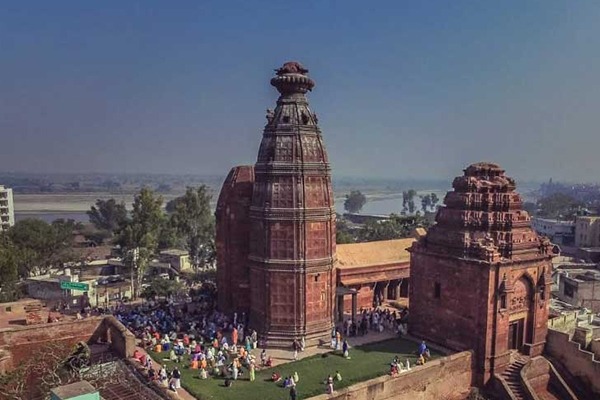(This post has been contributed by an Anonymous resident of Vrindavan)
“They obviously do not understand the bhakti of Bhagwan Ram.”
—Acharya Satyendra Das¹
“Banaras had an old puranic identity, a historical identity, which the present government has completely destroyed.”
—Rajendra Tiwari, priest at Kashi Vishwanath²
In what can only be called a searing indictment of my town’s recent descent into religious theatrics, I intend to bring the attention of the secular citizens of my country towards a broader yet metaphysically complex and sensitive issue: an unprecedented rise in the capitalization of faith; the superficial existence of religion on the peripheries of raw spiritualism, far removed from the principles and practices of an introversive character of the religion itself. This deceitful malpractice has been relentlessly perpetrated by the incumbent power play at work. The embracement of religion has either become a perversion of political stimuli, angry nationalism, or just blatant fascism.
Quoting a thoroughly misguided fellow native: the nativity of Vrindavan is biologically practical only if someone was to “take four successive births at an individual rate,” that is to say that an immigrant is unwelcome unless they have taken four successive births in the said geographical area of the town to fully be acknowledged as a native, thus setting the narrative for caste purity.
The road to realization of the self could not be limited to a said family, electoral constituency, or nativity; however, recent trends in political Hinduism have subjected the availability of spiritualism to either the capitalist or the bureaucrat, limiting the involvement of the general public to fanaticism. With the rise of “oligarchic capitalism in Modi’s India,” as characterized by a prominent publication aligned with the left-leaning opposition, religious institutions have suffered in their original orthodox structure, paving inroads for capital exploitation, market manipulation, and cultural degeneracy.
The local Brahmin, having abandoned his duties, has turned towards estate and indulgence, as declared by Kanchi Mahaperiyava Sri Chandrasekarendra Saraswati³:
“The Brahmin abandoned his duty of studying the Vedas and the cessation of karma. The scriptures say that he should not be enslaved by money; he should not accumulate property. As long as he lived his life accordingly and created worldly prosperity through the recitation of the Vedas and sacrifices, Now, having left his profession, leaving the village, and coming to the city, he took the education given by the Englishman, the job he offered, and his way of life, and because of this, he became something of a civilized man.”
The prevalence of the rising cost of living, uncontrollable conflux of ill-informed tourists, and bureaucratic failure in centers of religion—including Kashi, Ayodhya, and Vrindavan—is a testimony to the withering of religion-based vote bank politics and the current economic model. The upcoming Banke Bihari Corridor, in succession to a homogenized narrative beginning with the Kashi Vishwanath Corridor and Ayodhya Rampath projects, represents a modern paradox: it claims to honor Hindu traditions while simultaneously erasing the very communities, histories, and spaces that have defined these sacred landscapes for centuries.
What was once an organic spiritual ecosystem is being redesigned for a curated, commercialized religious experience, transforming pilgrimage into corporatized pilgrimage tourism. This ruthless facet of Hindutva urbanism is a real estate venture that caters to upper-class religious consumers, not the devotee or the original inhabitants of these spaces. With the rise of corporate tourism, the intimacy of an individual’s endeavor of divine revelation is being streamlined, commodified, and repackaged into a Disneyland-style religious transaction, complete with guided tours, VIP passes, and premium accommodations.
While historiography has remained contested since the days of initial translations, political influences have allowed a personal attestation on scriptural history, allowing close affiliates to supplement a superficial understanding of the religion, often deliberately erasing unconventional (to the contemporary) histories and presenting forth an efficient, swift, and convenient approach to religion.
The crossroads at which we now stand present a profound and unsettling dilemma: Is the ordinary citizen, masquerading as an ideologue, truly demonstrating signs of vairagya (renunciation), or is this merely a convenient illusion? If indeed they are embracing renunciation, does it extend beyond mere symbolism? Are they genuinely prepared to relinquish not only their material possessions but also the far more insidious attachments: their self-centered majoritarian ego, their fervent and often misplaced nationalism, their relentless pursuit of political dominance, their lust for power and estate, or even baseless ritualism?
Furthermore: Does anyone truly have the right to claim ownership over, profit from, or exert control over a space that is, by its very nature, divine? Can sacred spaces—imbued with centuries of devotion, history, and collective faith—be reduced to mere commodities, auctioned off to the highest bidder or repurposed for political and economic gain? Or does their sanctity transcend the temporal desires of individuals and institutions alike, resisting the forces of capitalistic exploitation and majoritarian entitlement?
With the incumbency’s decreasing vote share in Varanasi (63.62 percent in 2019 to 54.24 percent in 2024 Lok Sabha Elections) and Mathura (58.12 percent in 2019 to 42.16 percent in 2024), and the opposition’s victory in the Faizabad Lok Sabha seat, signals a shift in voter priorities beyond religious politics. The opposition has effectively mobilized local discontent; now, with rising tensions in Vrindavan, the power play must set its priorities right if it intends to claim their victory parade in the impending elections of the decade.
Footnotes:
- “Ram Mandir Head Priest Who Opposed Hindutva Politics Over Ram Dies,” The Wire, February 28, 2024, https://thewire.in/religion/ram-mandir-head-priest-who-opposed-hindutva-politics-over-ram-dies.
- Arpita Sen, “The Kashi Vishwanath-Gyanvapi Equation: A Parable for People, Power, Politics,” The Wire, February 28, 2024, https://thewire.in/communalism/the-kashi-vishwanath-gyanvapi-equation-a-parable-for-people-power-politics.
- Kanchi Kamakoti Peetham, “Thirukkural – Kural 36,” accessed February 28, 2025, https://www.kamakoti.org/tamil/part1kural36.htm.
Discover more from Drishtikone
Subscribe to get the latest posts sent to your email.
